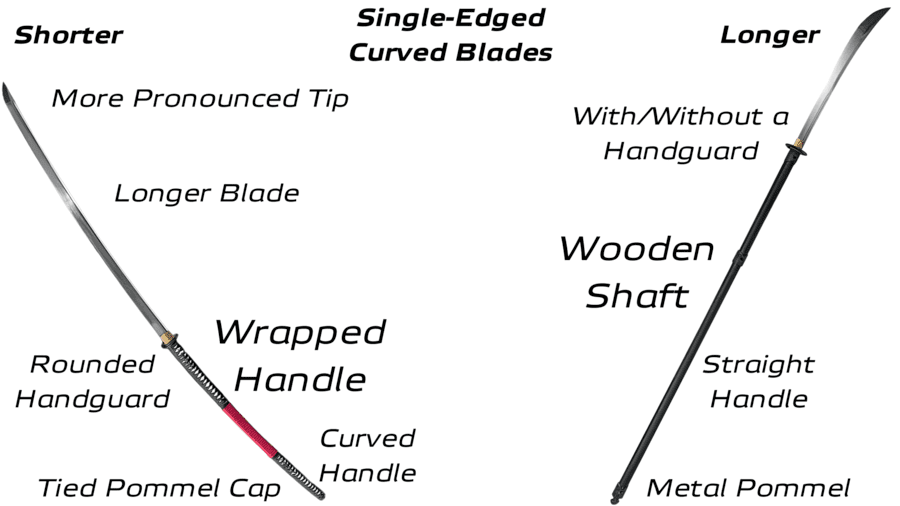Nagamaki vs Naginata: How Are They Different?
NO AI USED This Article has been written and edited by our team with no help of the AI

The nagamaki and naginata are iconic samurai weapons commonly seen in anime and both combine elements of the polearm and the sword. Due to their shared attributes, they are often mistaken for one another, but they differ in terms of their evolution, structure, and combat use.
In this article, we explore their similarities and differences.
What is a Nagamaki & Naginata?

The nagamaki is a two-handed sword with a massive handle, almost the same size as its blade. Its name translates to ‘long wrap’.
The naginata is a polearm sword. It has a polearm-like wooden handle with a full-tang blade shaped like a traditional Japanese sword.
Nagamaki

While the nagamaki is a long sword, it is shorter than the naginata, although its blade is longer, heavier, broader, and wider. It is sometimes curved like a naginata blade and its kissaki (tip) comes to a point, allowing for deeper stabs.
- Size: ~63 inches (160 cm)
- Weight: 4.4 lbs (2 kg)
The handle of the nagamaki sword is tied in a tsuka–maki (pattern) style, similar to a katana or tachi. It can be made of cotton, silk, or leather. It has multiple pegs and a rounded handguard with a tied kashira (pommel cap) at the end. Unlike the naginata, it has a curved handle.
Naginata

The naginata has a much shorter blade with a prominent curvature, which can vary in size. It usually has no yokote (defined tip).
- Size: ~79 inches (200 cm)
- Weight: ~5.5 lbs (2.5 kg)
It has a straight wooden handle that is longer than the nagamaki’s and is similar to other Japanese polearms. The wooden shaft is usually lacquered and sometimes has a tsuba (handguard). To counter its weight, the naginata has a proper metal pommel that varies in shape.
Different Combat Uses
Due to its size and the substantial length of its handle, the nagamaki could be used both as a polearm and a sword (for chopping attacks). This made it an ideal weapon against calvary and armored units. It is also well suited to charging fortified settlements from the front.

“Taking advantage of its weight, the nagamaki could cut off an opponent’s arm with one swing and even break the opponent’s bones through armor. In addition, it was used to sweep the enemy horse legs”, says Toda Fujinari, an expert in Japanese weapons and armor.
The naginata is longer. It has a polearm shaft and a curved blade that functions like a sword. It is used primarily for slashing but its blade design allows for thrusting and hooking too. It was a popular anti-cavalry weapon among mounted armored samurai.
History and Evolution

The naginata predates the nagamaki and early examples have been traced back to ancient China. It is believed to have evolved from the sickle and became a standalone weapon as early as the late Nara and Heian Period (8th-12th century).
The nagamaki did not evolve from the naginata, as is commonly thought. It is in fact a variation of the nodachi/odachi, Japan’s largest two-handed sword.

To make the nodachi easier to wield, half of the length of its blade was blunt and wrapped with a cord. This was referred to as nagamaki nodachi. Eventually, this evolved into a proper handle that extended about halfway along the blade’s length, called a nagamaki.
Both the naginata and the nagamaki were battlefield weapons during the Muromachi period (14th-16th century). Because they were difficult to carry in everyday life, most were banned during the peaceful Edo Period (17th-19th century).
Over time, their blades were reforged to make smaller-sized weapons like the katana, the wakizashi, or the tanto, known as naoshi blades.




